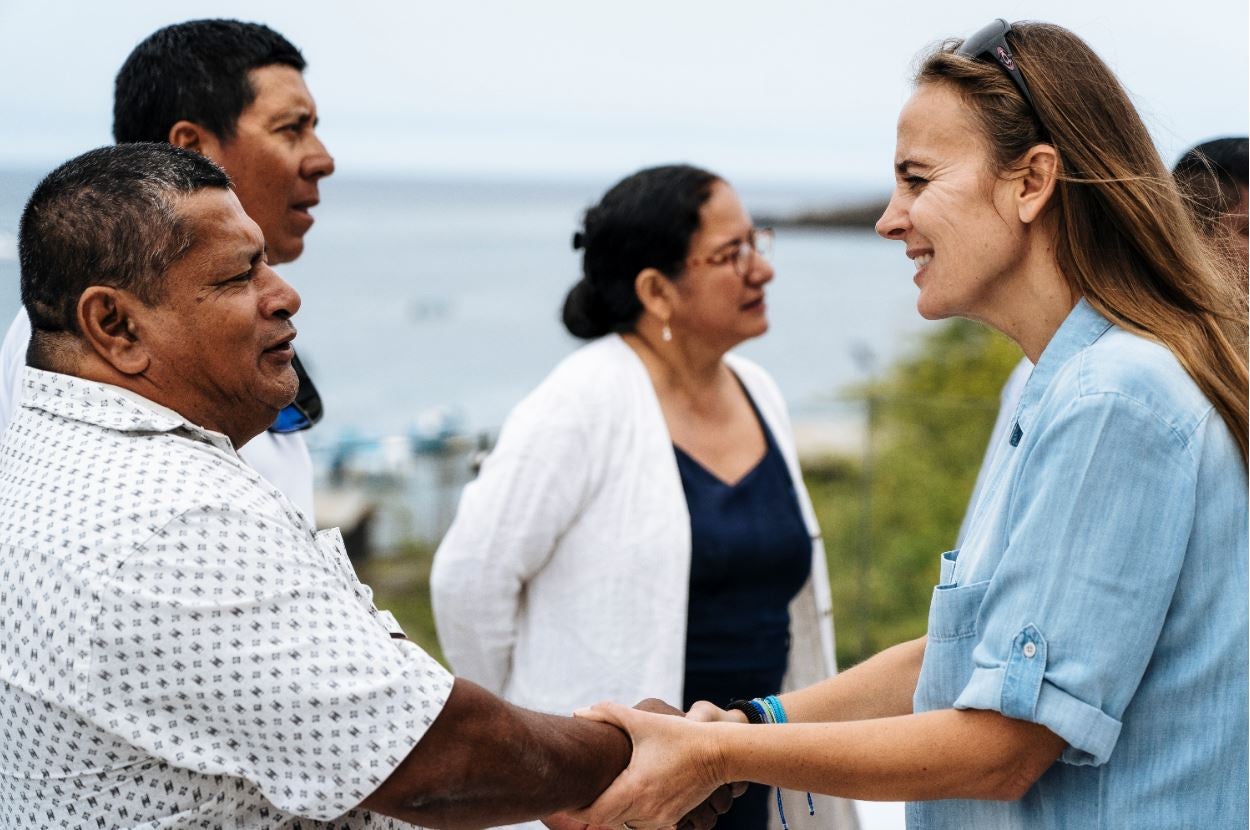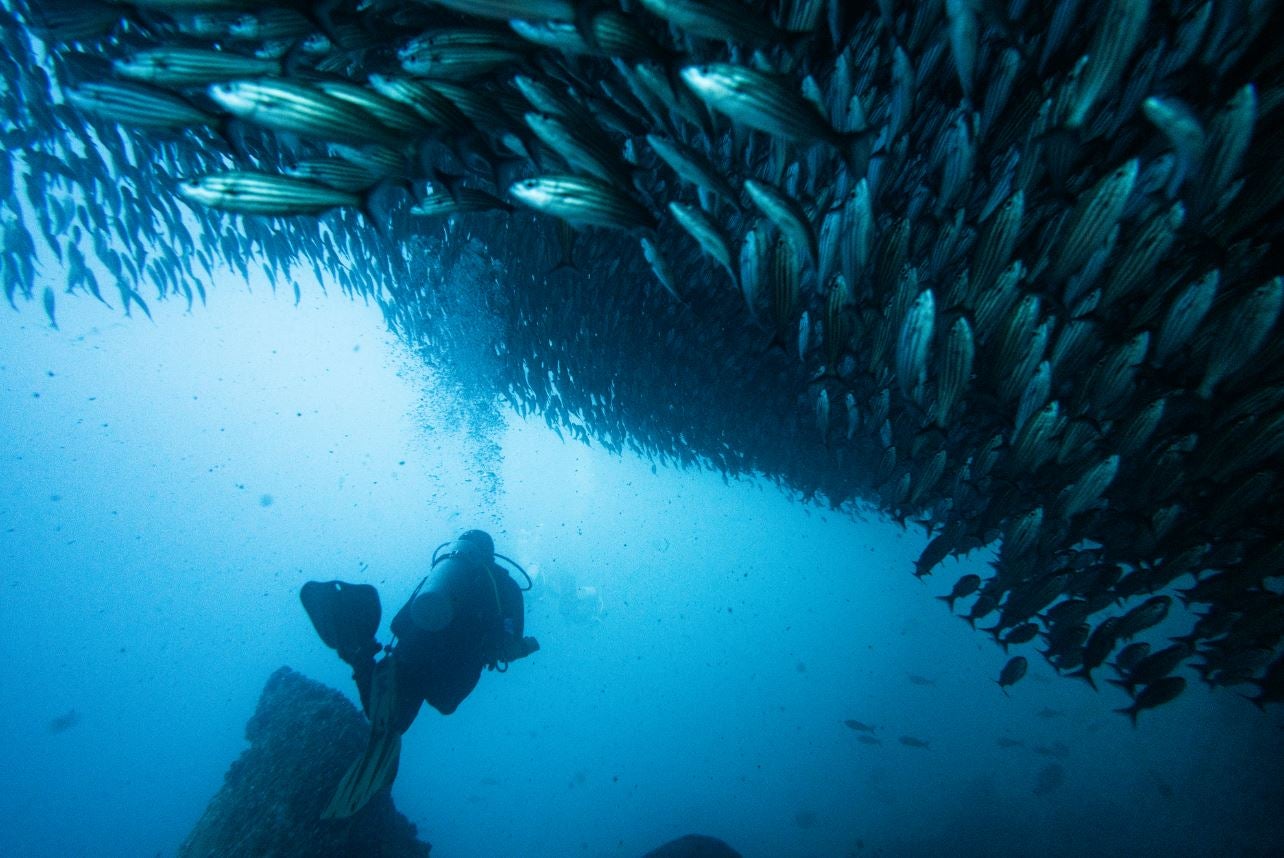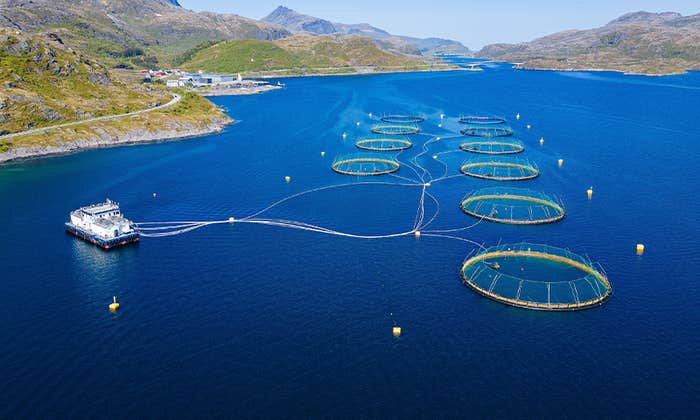Ever since she was a little girl on her father’s sailboat, the ocean has been part of Dona Bertarelli’s life. She would grow up to be a world-class sailor, becoming just the second woman to win the Bol d’Or Mirabaud—the world’s most prestigious inland regatta—and holding the record of fastest woman to sail around the globe. She would also become a world-class conservationist, co-founding the Bertarelli Foundation in 1998 and helping guide the establishment of marine protected areas throughout the world.
That process taught Bertarelli about the human complexity of conservation. Protecting ocean ecosystems is less a matter of science than of sociology, economics, and politics; it requires balancing the interests and ambitions of many stakeholders, from researchers to governments to all those people whose livelihoods depend on marine resources. And as daunting as that can be in any one locale, conservation scientists say that 30 percent of the ocean needs protection. That’s more than ten times the area now protected.
It’s a leviathan project, demanding a radical overhaul of how humans relate to the ocean and its life. People accustomed to treating them as an endless resource in the pursuit of short-term benefits will need to think generations into the future. Industries will be disrupted. Communities that rely on uncertain sources of income—tourism, declining fisheries—will have to find new sources of security. And all this must happen in a way that spreads, rather than concentrates, wealth and power.
Yet Bertarelli is confident. The key, says Bertarelli, who last year became Special Adviser for the Blue Economy to the United Nations Conference on Trade and Development, is balancing economic growth with ecological—and ultimately human—well-being. “We must combine production and protection,” she says. “One cannot go without the other.”
Nautilus recently talked to Bertarelli about her work and the future of ocean conservation.
When did you know you would devote yourself to becoming an ocean advocate?
You protect what you love, and you love what you know and understand. The ocean has been a big part of my upbringing. It wasn’t a conscious decision so much as a growing awareness of that love, what needed to be done in ocean conservation, and what my role could be.
In the case of ocean conservation, the science is clear that protection is needed—and indeed very high levels of protection are needed—to allow the ocean to recover from human impacts, help mitigate climate change, safeguard marine biodiversity and continue to play its life-giving role.
Through the Bertarelli Foundation, we support programs in marine protection and marine science around the world. The Pew Bertarelli Ocean Legacy project, a partnership with The Pew Charitable Trusts, works to create large and highly protected marine protected areas (MPAs) in ecologically significant parts of the ocean.

There is a growing body of science which shows the importance of protecting more than 30 percent of the ocean by 2030—going even further than the United Nations Sustainable Development Goals, which calls for conserving 10 percent of coastal and marine areas. The High Ambition Coalition for Nature and People was just launched, with 50 countries so far committed to the same 30 percent protection on land and on water by 2030, and calling for other countries to join.
Creating MPAs is a process that can take years of local engagement and advocacy. We work with multiple stakeholders, which means we work with philanthropic partners, indigenous groups, community leaders, government officials, and scientists. We commission research on topics such as the impact of overfishing on biodiversity or analyzing the potential economic outcomes of establishing a marine protected area. As partners, we’ve helped secure protection of over eight million square kilometers of ocean. But despite this progress, governments have succeeded in fully protecting just 2.6 percent of the global ocean.
Is the goal of protecting 30 percent of the ocean by 2030—within just ten years—feasible and, more importantly, enforceable? Who is responsible? Who is leading the way?
It’s feasible with strong political will, responsible leadership, and the capacity to value the long-term economic benefits of conserving nature over short-term economic benefits.
To achieve this ambitious goal, 30 percent ocean protection is needed not only within countries’ Exclusive Economic Zones but also on the high seas, waters which are common to all countries. The UK is leading the way, having created the Global Ocean Alliance which champions a minimum 30 percent protection of the global ocean through marine protected areas by 2030; there are now 41 countries which have joined the alliance. They now each need to deliver on their commitment. Countries such as the Seychelles have already done so, and are also an inspiration for the potential of the blue economy.
The world’s seventh-largest economy doesn’t belong to a single country; it’s the ocean.
In terms of whether marine protected areas are enforceable, we have the solutions: satellite imagery, port state measures, transparency of fishing vessels data through automatic identification systems, and more. We need to avoid the creation of ‘paper parks’ in the ocean. This is why I’m supporting a project on enforcement and management of MPAs through technology and data analysis which will help decision-makers and park managers as a complement to traditional enforcement measures like patrols.
What is the difference between the ocean economy and the blue economy? What does it encompass, and what are the challenges?
I like to speak about a sustainable blue economy, as we must combine production and protection. One cannot go without the other. Ocean health is key to a sustainable blue economy.
I envision a sustainable blue economy as different from the ocean economy because it derives value from the ocean, seas and coastal areas, and succeeds in tapping into marine resources for economic growth, while protecting the health of the ocean ecosystem and enabling sustainable use for generations to come.
The world’s seventh-largest economy based on gross domestic product (GDP), valued at $2.5 trillion to $3 trillion annually, doesn’t belong to a single country; it’s the ocean. The ocean supports the livelihoods of more than 3 billion people, of which about 60 million people are employed in the fisheries and aquaculture industries.
The ocean economy’s four major sectors of fisheries and aquaculture, marine transport, energy, and tourism all have a major impact on marine ecosystems. These industries have traditionally viewed the ocean as a resource for production—rather than valuing and protecting the ocean and its biodiversity so as to sustain humanity long-term. Nearly 90 percent of the world’s marine fish stocks are now fully exploited, overexploited or depleted. Looking at the ocean purely as a production resource is incredibly short-sighted.

How can you make a blue economy a reality? What has been achieved so far, and what are the potential futures?
Apart from the four major sectors, there is a need to diversify towards economic areas that will have a lower impact on marine ecosystems, while creating jobs. These new areas include marine bioprospecting, research and development, sustainable aquaculture, renewable energy, as well as ecotourism and blue carbon. And instead of focusing only on the returns from harvesting and extracting the ocean’s resources, we need to have a major paradigm shift—providing an economic value for conserving marine life.
The value of conservation and of an ecosystem’s biodiversity, such as the fish, coral reefs, mangroves, and seagrass that help protect against flooding and storm surges in addition to storing carbon: all need to be assessed versus the economic value of harvesting and extracting these resources, which is how the value of the ocean has been calculated so far. I was fascinated by the work an economist from the International Monetary Fund who estimated that a great whale is worth $2 million alive, but just $80,000 once dead, as it absorbs the equivalent in carbon dioxide of 30,000 trees each year.
Speaking of carbon, blue carbon is the carbon stored in coastal ecosystems such as mangroves, tidal marshes and seagrass meadows. These coastal areas can store 10 times more carbon per unit of area than terrestrial forests and are now being recognized for their role in mitigating climate change. However 20-50 per cent of the world’s mangrove, seagrass and salt marsh areas have been destroyed, so it’s vital to protect and restore these areas. And it’s equally important to create economic value from protecting these blue carbon ecosystems, through emissions trading in carbon credits. For small island developing states (SIDS), it is also important to derive more value from the ocean resources they trade.
An economist from the International Monetary Fund estimated that a great whale is worth $2 million alive, but just $80,000 once dead.
They’re called ‘small island’ states, but as Ronald Jumeau, Seychelles Ambassador to the United Nations, says, they are actually ‘great ocean’ states. That’s because SIDS have exclusive access to a sea area more than 20 times their collective land area. The 39 SIDS in the Caribbean, the Pacific, and Africa, Indian Ocean and South China Sea have a combined population of 63.2 million people and a combined gross domestic product (GDP) of $575.3 billion.
The blue economy provides SIDS with a path to sustainable economic growth, social inclusion, and improvement of livelihoods. But SIDS often lack the capacity, skills, and financial support to better develop their blue economy. This means investments are needed to help bridge the gaps in knowledge, best practices, innovation, capacity, and finance so SIDS can grow sustainable ocean economies.
Island states like the Seychelles are bridging that gap by not only declaring 30 percent of its waters protected areas but also by issuing the world’s first sovereign blue bonds. The proceeds are being used to support sustainable and fisheries projects. It is innovative ocean financing tools like blue bonds for conservation which can help SIDS unlock funds to invest in their blue economy.

Palau has designated 80 percent of its territorial waters as a marine sanctuary. And by focusing tourism efforts on attracting smaller numbers of tourists, and being the first country to make all visitors sign a pledge to respect the island’s environment, Palau is rethinking sustainable tourism.
The social inclusion of women is also extremely important for the blue economy. Women make up the majority of the workforce in the informal hospitality and fishery sectors. In fact, women make up the bulk of low-skilled workers in the tourism industry in SIDS and elsewhere around the world. So, we need not only a sustainable but also an inclusive and equitable blue economy. Investing in women, and respecting their rights and welfare, can help women become game changers in the blue economy.
Governments need to ensure gender equality is a right protected by legislation. Policies for equal representation are needed specifically for the tourism and fishery sectors. Active participation by both women and men in these industries will help advance gender equality throughout the blue economy.
What effect has the COVID-19 pandemic had on the blue economy and what lessons can be learned?
The United Nations Conference on Trade and Development (UNCTAD) estimated that trade may drop by 27 percent and exports of fish and other seafood products may also be reduced by a third. The coastal communities which depend on a limited set of activities—like fisheries, port and logistical services, and tourism—are clearly among those most impacted.
Global tourism has been brought almost to a standstill; in some SIDS, tourism accounts for as much as 80 percent of their exports. In September last year, UNCTAD estimated losses in the most pessimistic scenario, a 12-month break in international tourism, to be as high as $3.3 trillion or 4.2 percent of global GDP. Their heavy reliance on tourism shows the need to support SIDS in diversifying blue economy sectors, to build their resilience against future crises. This will take commitment and time to build back better.
The risk of zoonotic diseases spreading to humans increases as we destroy forests and wild animals’ natural habitats, and come into closer contact with animals through the wildlife trade or intensive farming. If we consider that the International Monetary Fund projects the pandemic-induced cumulative loss in economic output at $28 trillion by 2025, this must surely pale in comparison with the cost of protecting biodiversity and at the same time reducing the risk of zoonotic diseases.
We are at a crossroads in history. Countries need to choose between going back to the way we used to do business, or taking the green and blue road.
We are at a crossroads in history. Countries need to choose between going back to the way we used to do business, or taking the green and blue road to a sustainable blue recovery. It isn’t a binary choice between production and protection: both are possible in a healthy ocean economy.
Governments should include green and blue sustainability conditions within stimulus packages and economic recovery measures. Investment in coastal and marine ecosystem restoration are among a few sectors where immediate economic growth could be created. Investments made now are also an opportunity to improve long-term economic resilience globally. Innovative financial instruments like blue bonds or sovereign bonds, debt-for-nature swaps, corporate social responsibility investment, and blended financing—which combines development finance with philanthropic funds—are all needed to finance the transition towards more sustainable ocean economy sectors.
Financial markets and institutions must play a key role in advancing a sustainable blue economy. The European Investment Bank, for example, invests in the sustainable blue economy and supports initiatives to reduce pollution and conserve marine ecosystems. The World Bank launched PROBLUE in 2018. This is a multi-donor trust fund worth about $5 billion, with an additional $1.65 billion expected. So far, the fund has initiated over 30 analytical activities and partnered with more than 60 countries to build sustainable ocean economies. Its focus is on improved fisheries governance, marine pollution management, seascape management, and the sustainability of oceanic sectors, including shipping and renewable energy. The Natural Capital Alliance, established by His Royal Highness The Prince of Wales under his Sustainable Markets Initiative and founded by HSBC Pollination Climate Asset Management, Lombard Odier, and Mirova, was launched during the One Planet Summit and aims to mobilize $10 billion by 2022.

What part does UNCTAD play in international politics and achieving the blue economy?
UNCTAD supports developing countries to access the benefits of a globalized economy more fairly and effectively. It provides analysis, facilitates consensus-building, and offers technical assistance to member states on the subjects which matter to their growth and their economy. This helps developing countries to use trade, investment, finance, and technology to achieve inclusive and sustainable development.
Mukhisa Kituyi, the former UNCTAD Secretary-General, emphasized the blue recovery efforts needed to achieve the Sustainable Development Goals in his report in December about trade and development in a post-pandemic world. UNCTAD has clearly seen the opportunity of expanding a blue economy for many years, in particular for SIDS, through its many reports, data and analyses. It provides a framework and solutions to address multiple issues like climate change impacts and mitigation, environmental vulnerability and adaptation, as well as biodiversity loss. This is critical information and policy analysis for government decision-makers, but also for financial institutions and the private sector.
How does your role as Special Adviser for the Blue Economy fit in?
As an ocean advocate and as an entrepreneur, I’m very aware of the importance of balancing the need to protect the ocean with the need to drive sustainable economic growth. I also have a special focus on SIDS, who are on the front lines of climate change and heavily reliant on the ocean for their survival. So I advocate for not only a sustainable blue economy, to raise awareness of its potential for growth, livelihoods and the environment, but also for the use of innovative financial instruments to fund the development of sustainable blue economy sectors.
Gender equality and women empowerment are key to progress, so as a woman, and as a founding patron of the Womanity Foundation, I am also committed to supporting the sustainable development goal of advancing gender equality. I also think my role as UNCTAD Special Adviser for the Blue Economy is to advocate for collaboration across sectors, and with all stakeholders, to make a sustainable and regenerative blue economy a reality.
Lead image: Martha Iserman
The Bertarelli Foundation is a partner in Nautilus Oceans.



































